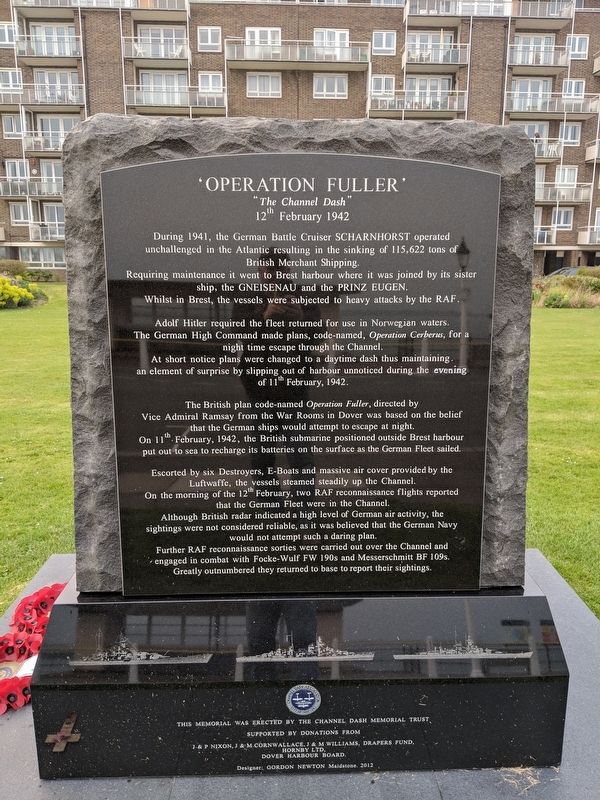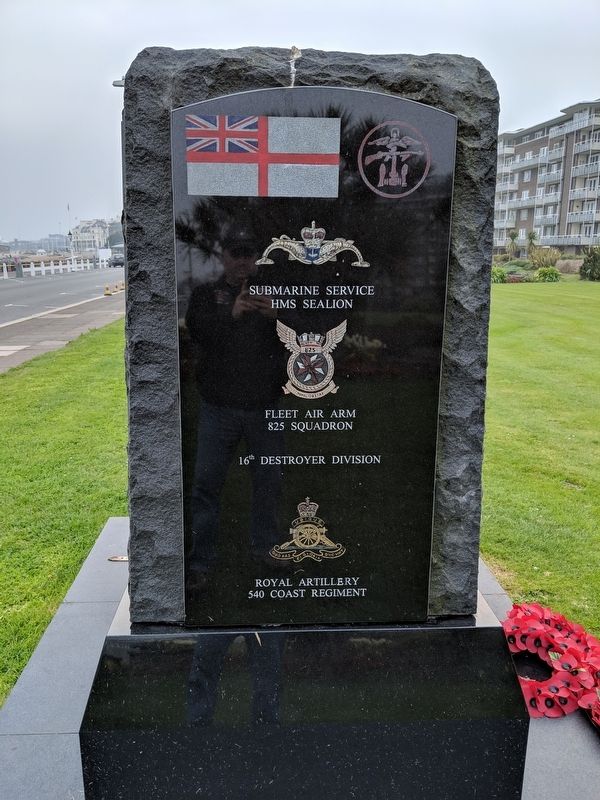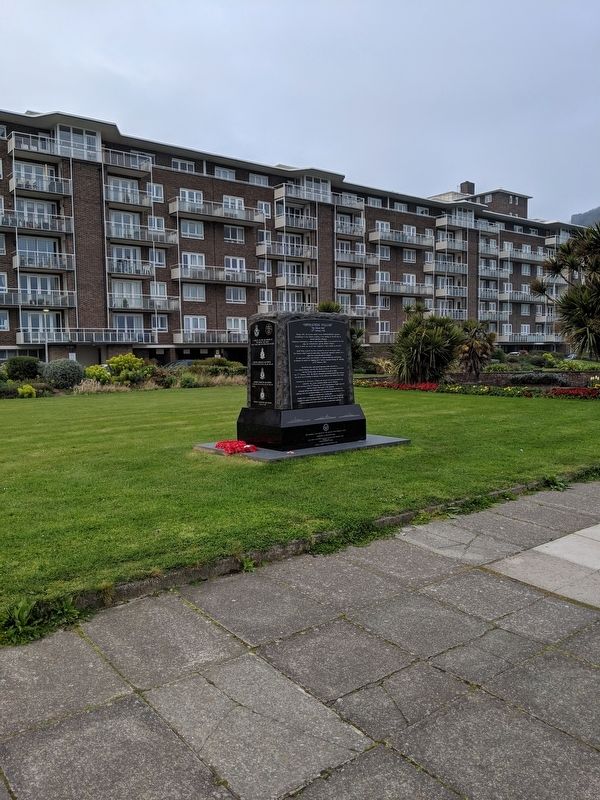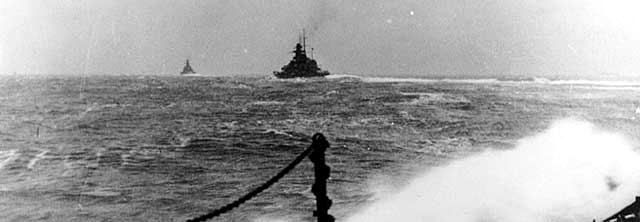Dover in Kent, England, United Kingdom — Northwestern Europe (the British Isles)
Operation Fuller
"The Channel Dash"
— 12th February 1942 —
During 1941, the German Battle Cruiser SCHARNHORST operated unchallenged in the Atlantic resulting in the sinking of 115,622 tons of British Merchant Shipping. Requiring maintenance it went to Brest harbour where it was joined by its sister ship, the GNEISENAU and the PRINZ EUGEN. Whilst in Brest, the vessels were subjected to heavy attacks by the RAF.
Adolf Hitler required the fleet returned for use in Norwegian waters. The German High Command made plans, code-named, Operation Cerberus, for a night time escape through the channel. At short notice plans were changed to a daytime dash thus maintaining an element of surprise by slipping out of harbour unnoticed during the evening of 11th February, 1942.
The British plan code named Operation Fuller, directed by Vice Admiral Ramsay from the War Rooms in Dover was based on the belief that the Germans would attempt to escape at night. On 11th February, 1942, the British submarine positioned outside Brest harbour put out to sea to recharge its batteries on the surface as the German Fleet sailed.
Escorted by six Destroyers, E-Boats and massive air cover provided by the Luftwaffe, the vessels steamed steadily up the Channel. On the morning of the 12th February, two RAF reconnaissance flights reported that the German Fleet were in the Channel. Although British radar indicated a high level of German air activity, the sightings were not considered reliable, as it was believed that the German Navy would not attempt such a daring plan. Further RAF reconnaissance sorties were carried out over the Channel and engaged in combat with Focke-Wulf FW 190s and Messerschmitt BF 109s. Greatly outnumbered they returned to base to report their sightings.
Topics. This historical marker is listed in these topic lists: Air & Space • War, World II • Waterways & Vessels. A significant historical date for this entry is February 11, 1942.
Location. 51° 7.436′ N, 1° 19.076′ E. Marker is in Dover, England, in Kent. Marker is on Marine Parade just east of Wellesley Road, on the right when traveling west. Touch for map. Marker is in this post office area: Dover, England CT16 1LQ, United Kingdom. Touch for directions.
Other nearby markers. At least 8 other markers are within walking distance of this marker. The Royal Norwegian Navy (a few steps from this marker); Capt Matthew Webb (within shouting distance of this marker); Charles Stewart Rolls (within shouting distance of this marker); Old Market Hall (approx. 0.3 kilometers away); Market Square (approx. 0.3 kilometers away); Instruments of Punishment (approx. 0.4 kilometers away); Rebuilt Bank (approx. 0.4 kilometers away); St. Mary’s Church and Cannon Street (approx. 0.4 kilometers away). Touch for a list and map of all markers in Dover.
Also see . . .
Channel Dash. Wikipedia entry (Submitted on December 9, 2022, by Larry Gertner of New York, New York.)
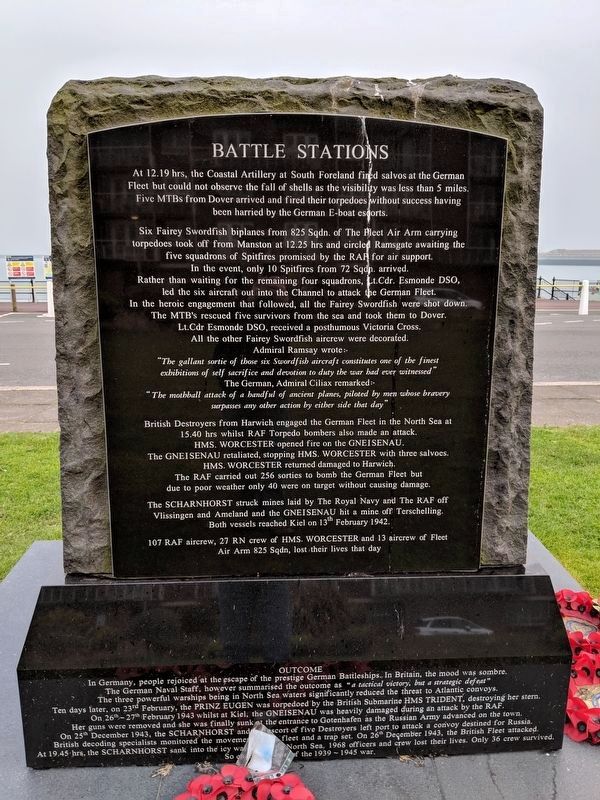
Photographed By Mike Wintermantel, April 7, 2019
3. Operation Fuller Marker
Side C
BATTLE STATIONS
At 12.19 hrs, the Coastal Artillery at South Foreland fired salvos at the German Fleet but could not observe the fall of shells as the visibility was less than 5 miles. Five MTBs from Dover arrived and fired their torpedoes without success having been harried by the German E-boat escorts.
Six Fairey Swordfish biplanes from 825 Sqdn. of the Fleet Air Arm carrying torpedoes took off from Manston at 12.25 hours and circled Ramsgate awaiting the five squadrons of Spitfires promised by the RAF for air support. In the event, only 10 Spitfires from 72 Sqdn. arrived. Rather than waiting for the remaining four squadrons, Lt. Cdr. Esmonde DSO, led the six aircraft out into the channel to attack the German Fleet. In the heroic engagement that followed, all the Fairey Swordfish were shot down. The MTBs rescued five survivors from the sea and took them to Dover. Lt. Cdr. Esmonde DSO, received a posthumous Victoria Cross. All the other Fairey Swordfish aircrew were decorated.
Admiral Ramsay wrote:
"The gallant sortie of those six Swordfish aircraft constitutes one of the finest exhibitions of self sacrifice and devotion to duty the war has ever witnessed."
The German, Admiral Ciliax remarked:
"The mothball attack of a handful of ancient planes, piloted by men whose bravery surpasses any other action by either side that day."
British Destroyers from Harwich engaged the German Fleet in the North Sea at 15.40 hrs whilst RAF torpedo bombers also made an attack. HMS. WORCESTER opened fire on the GNEISENAU. The GNEISENAU retaliated, stopping HMS. WORCESTER with three salvos. HMS. WORCESTER returned damaged to Harwich. The RAF carried out 256 sorties to bomb the German Fleet but due to poor weather only 40 were on target without causing damage.
The SCHARNHORST struck mines laid by the Royal Navy and the RAF off Vlissingen and Ameland and the GNEISENAU hit a mine off Terschelling. Both vessels reached Kiel on 13th February 1942.
107 RAF aircrew, 27 RN crew of HMS. WORCESTER and 13 aircrew of Fleet Air Arm 825 Sqdn. lost their lives that day.
BATTLE STATIONS
At 12.19 hrs, the Coastal Artillery at South Foreland fired salvos at the German Fleet but could not observe the fall of shells as the visibility was less than 5 miles. Five MTBs from Dover arrived and fired their torpedoes without success having been harried by the German E-boat escorts.
Six Fairey Swordfish biplanes from 825 Sqdn. of the Fleet Air Arm carrying torpedoes took off from Manston at 12.25 hours and circled Ramsgate awaiting the five squadrons of Spitfires promised by the RAF for air support. In the event, only 10 Spitfires from 72 Sqdn. arrived. Rather than waiting for the remaining four squadrons, Lt. Cdr. Esmonde DSO, led the six aircraft out into the channel to attack the German Fleet. In the heroic engagement that followed, all the Fairey Swordfish were shot down. The MTBs rescued five survivors from the sea and took them to Dover. Lt. Cdr. Esmonde DSO, received a posthumous Victoria Cross. All the other Fairey Swordfish aircrew were decorated.
Admiral Ramsay wrote:
"The gallant sortie of those six Swordfish aircraft constitutes one of the finest exhibitions of self sacrifice and devotion to duty the war has ever witnessed."
The German, Admiral Ciliax remarked:
"The mothball attack of a handful of ancient planes, piloted by men whose bravery surpasses any other action by either side that day."
British Destroyers from Harwich engaged the German Fleet in the North Sea at 15.40 hrs whilst RAF torpedo bombers also made an attack. HMS. WORCESTER opened fire on the GNEISENAU. The GNEISENAU retaliated, stopping HMS. WORCESTER with three salvos. HMS. WORCESTER returned damaged to Harwich. The RAF carried out 256 sorties to bomb the German Fleet but due to poor weather only 40 were on target without causing damage.
The SCHARNHORST struck mines laid by the Royal Navy and the RAF off Vlissingen and Ameland and the GNEISENAU hit a mine off Terschelling. Both vessels reached Kiel on 13th February 1942.
107 RAF aircrew, 27 RN crew of HMS. WORCESTER and 13 aircrew of Fleet Air Arm 825 Sqdn. lost their lives that day.
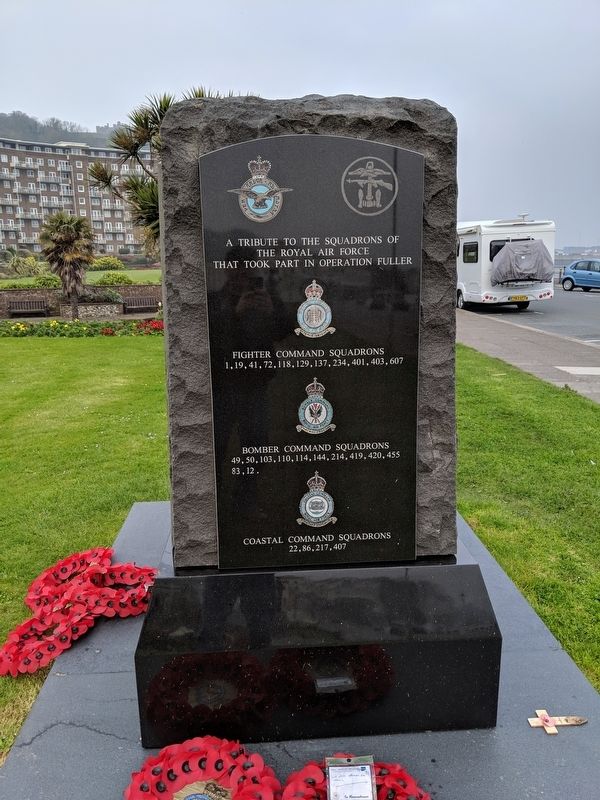
Photographed By Mike Wintermantel, April 7, 2019
4. Operation Fuller Marker
Side D
A Tribute to the Squadrons of the Royal Air Force that took part in Operation Fuller
Fighter Command Squadrons 1, 19, 41, 72, 118, 129, 137, 234, 401, 403, 607
Bomber Command Squadrons 49, 50, 103, 110, 114, 144, 214, 419, 420, 455, 83, 12.
Coastal Command Squadrons 22, 86, 217, 407
A Tribute to the Squadrons of the Royal Air Force that took part in Operation Fuller
Fighter Command Squadrons 1, 19, 41, 72, 118, 129, 137, 234, 401, 403, 607
Bomber Command Squadrons 49, 50, 103, 110, 114, 144, 214, 419, 420, 455, 83, 12.
Coastal Command Squadrons 22, 86, 217, 407
Credits. This page was last revised on December 9, 2022. It was originally submitted on April 20, 2019, by Mike Wintermantel of Pittsburgh, Pennsylvania. This page has been viewed 383 times since then and 15 times this year. Photos: 1, 2, 3, 4, 5. submitted on April 20, 2019, by Mike Wintermantel of Pittsburgh, Pennsylvania. 6. submitted on December 9, 2022, by Larry Gertner of New York, New York.
